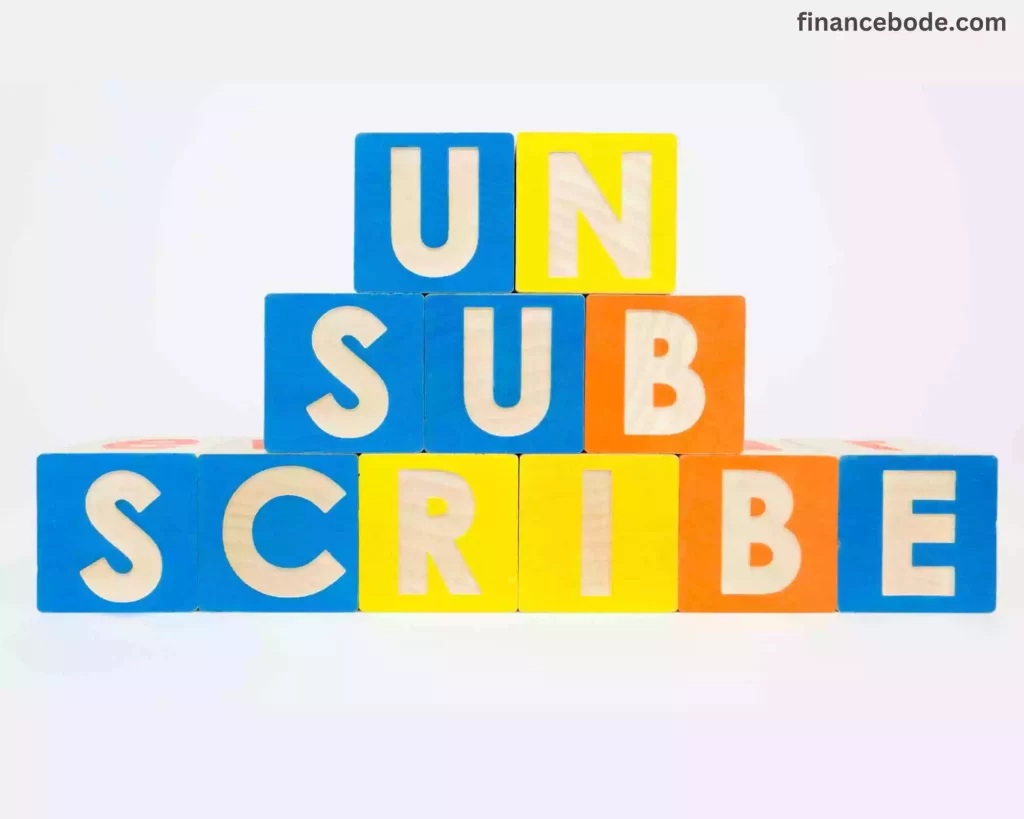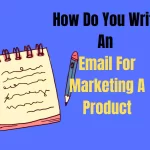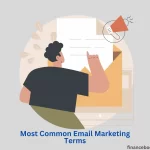Are you wondering why do people unsubscribe from marketing emails? People unsubscribe due to frequent emails, Irrelevant content, Spammy emails, Poorly written emails and a few more.
Email marketers recognize that not everyone will like their emails, and many will unsubscribe from them, too.
However, if email unsubscribe rates continue to fall, this is a sign that something is awry.
Email marketing has benefited businesses greatly and helped enhance the brand’s website rankings, so you will want to lower email unsubscribe rates promptly.
Reading these words, many people would think of asking consumers for feedback when they attempt to unsubscribe or modify email subject lines, etc.
Still, they are merely standard and transitory strategies.
Here are five clever methods to keep people on your email marketing list. Let’s go through it and apply together!
Let’s first have a brief look at why people subscribe to your Email at first.
See also: why emails get ignored by customers.
Why Do People Subscribe To Marketing Emails?
People subscribe to get Emails because they perceive the business’s Emails deliver value and will benefit them.
Here are some reasons people subscribe to get emails from your business:
People subscribe due to company announcements.
Some organizations prefer to send Emails as branded announcements allowing customers to view the inner workings of their company.
These Emails may contain press release-style announcements, staff information, or corporate blog articles.
Although this information may not be as loved as the content regarding discounts and deals, it nonetheless helps companies develop a professional and trustworthy image in the minds of consumers.
This is likely why 16% of the individuals signed up for Email to get company-specific alerts in their mailbox.
People subscribe due to freebies, discount coupons, and promotions while purchasing.
28% of consumers said they sign up for Email because they “want to be notified of promotions, coupon codes or coupons from a company.”
It is hardly surprising that emails regarding discounts and deals are so enticing to consumers. Even we ourselves will monitor Emails that deliver value and advantages to us.
Although the objective of these emails is to announce discounts and deals from the brand, companies may also make use of them to launch or tell clients of brand news or programs that the company is planning to arrange.
For example, while placing discount codes, offers or coupons at the top of Emails, you may also provide news about new goods or blog articles near the bottom of Emails.
People subscribe due to relevant content in Email.
Not all email subscribers desire to get the newest product offers. Sometimes, individuals join up for Emails only for the purpose of learning new things.
This explains why a quarter of participants said they join up for Emails because they want to frequently get “a brand’s content (i.e. blogs, videos, graphics).”
While Emails such as Blog posts or branded articles won’t bring fast results or drive rapid transactions, they will be a highly successful brand recognition technique.
For example, consumers who join up solely to view your material signal that they highly trust your company’s excellent content.
The more customers consume content from your brand, the more they are likely to form a “passive” impression.”
Meaning that when they read a lot of content created by your brand, at some point, their subconscious mind will default to remembering your brand name every time they want to buy a related product.
Now that we have got a better understanding of why people subscribe to your marketing email list let’s check out the main reason they unsubscribe.
Why Do Consumers Unsubscribe From Your Email Marketing?
Suppose you have a great customer email list. Not a shopping list, or you utilize software extracted from particular forums. What triggers this customer action to unsubscribe from the list?
1. You sent irrelevant content.
For example, you are a retail supermarket. Your consumer is male. They subscribe to get material regarding electrical and refrigeration items.
But you keep sending them emails on beauty items and cosmetics. It’s reasonable that people unsubscribe from emails.
Make sure you send them precisely what they want to receive. This illustrates why you need to target clients for email marketing campaigns.
Do not send the same generic email content to all customers. To achieve this, organize your list of consumers thoroughly according to their demands.
2. You send Email Marketing with too much frequency.
Emails coming in too regularly – 54% of Customers are likely to be getting too many emails from you in a particular period of time.
The greatest technique is that you should have a precise strategy for delivering email marketing and correct this time.
For example, you will send an email every Tuesday morning.
This also provides credibility to your brand. Sending emails with too much frequency can leave consumers irritated. And feel like email spam.
Consider an appropriate email frequency. See also: The optimum time to send email marketing.
3. Content is dull and does not add any value to consumers.
You have sent clients precisely what they asked for. But these materials are uninteresting; nothing leaps out.
If consumers believe the emails sent to them don’t deliver any value to them. They assume they are spending time reading the Email Marketing you send.
And they unsubscribe from the mail.
Remember, the basis of a marketing campaign is to make clients believe they will gain a lot of advantages; they will obtain the value they seek.
Let’s stand in the position of the consumer to compose the email content.
4. Customer demands and choice changes.
This is an objective reason that you cannot foresee. People’s choice and wants are continually evolving.
Therefore, their requirement to obtain Email Marketing is no exception.
For example, a woman joins up to get Email Marketing on items and care for newborns. But now their children are grown. And they no longer need to get this information.
With the aforementioned four explanations, have you identified the reasons for the customer’s unsubscribe action?
If it corresponds to reasons 1, 2 and 3, you need to make a sensible change immediately.
How Often Do Individuals Unsubscribe From Emails?
People will unsubscribe from your email list. It’s unfortunate, but it’s sure to happen.
Studies have estimated the average unsubscribe rate between 0.17 per cent and 0.52 per cent per Email sent.
That means that if you have a 2,000-person list, you will lose four to ten members for every Email you send.
So if you send eight emails a month, the stats show you’ll be shedding at least 30 subscribers—and maybe even closer to 80.
That seems discouraging. But… it’s not always all terrible news.
Obviously, you don’t want to lose the subscribers you fought so hard to gain, but not all subscribers are equally important.
In fact, several of them may have a negative impact on your email marketing efforts. So, as counterintuitive as it may seem, losing a few subscribers isn’t always a bad thing.
You simply want to make sure you’re losing the proper subscribers, which is to say the wrong subscribers for your firm are quitting your list.
How to Reduce Email Unsubscribe Rates
1. Categorize the Email list.
Email categorization lets you send the most relevant and valuable material to each consumer.
The more you classify your specialized email list, the more probable it is to produce material that addresses the interests and demands of your customers.
(Tip: If you are developing a lead care project, try gathering customers’ information based on website use patterns and then dividing them into distinct categories with a sending strategy. Suitable Email).
See also: How to categorize your email list.
2. Planned content.
After you have categorized your lists, you need to establish a content strategy for each step of your email marketing campaign.
You may utilize accessible tools such as Google Docs and Excel to plan or refer to professional templates for a more logical presentation.
Planning content in advance lets you deliver email content relevant to each unique consumer based on the purchase stage.
Besides, the content strategy allows you to monitor your job progress as well as campaign outcomes data.
Example: A client at the Review stage of the buying cycle should get Emails with the sort of: What issue does your company’s product/service assist them solving? What benefits? What aspects stand out from other services?
Finally, a content plan helps you detect the holes in your present email marketing approach.
By sending a request to re-select email frequency, you may save the circumstance where clients already wish to unsubscribe.
3. Allow clients to pick how frequently to get Email.
Currently, many firms have adapted this strategy to Email Marketing campaigns.
That is, as soon as they complete the registration form, customers may pick how frequently they want to receive newsletters throughout the week/month.
For example, one email/week, one email/month, or one email/every three days.
This approach lets organizations send Emails to clients with the proper timing, avoiding sending too much or too little.
Customers also feel more content since their ideas are appreciated, allowing you to lessen the danger of unsubscribing later.
4. Make email content unique.
The best strategy to lower unsubscribe rates is to make each Email unique and unique to the consumer.
Don’t merely send emails summarizing stuff that folks can certainly discover on the website.
Send emails with material customized to each consumer group, such as discounts, recommendations only for them, etc.
Then consumers would grasp the significance of subscribing and will welcome and look forward to getting your Email in their inbox.
5. Choose a suitable time to send an Email.
Many Email Marketing tools now include automated email-sending mode at preset time frames so that you may specify the right sending time for each distinct kind of Email.
Emails are sent automatically even after office hours, even if you don’t have to sit at the computer to do it personally.
For example: With some Email Marketing software, you can change the time that clients get an email with only a few easy clicks.
Sending emails at the proper moment helps you minimize the danger of upsetting clients and enhance email open rates.
Here are some suitable time frames to send Emails:
- Send Email before 9 am: when clients get to the workplace and access their inbox, they will notice your Email first in the mailbox, and the likelihood of opening the message is greater.
- 9 am-10 am: The beginning of a working day is the period when clients quickly absorb all the information.
- 3 am – 5 pm: for Emails containing side subjects such as financial news and real estate.
- 5 am – 7 pm: the time window that individuals desire to receive B2B promotional content.
- 7 am – 10 pm: The most common email opening time. Especially ideal for activities such as sports, fitness, events, e-commerce, spa and fashion, beauty, and tourist sectors.
You may send Emails to clients without having to sit at the computer to manually work email management and automated sending mode.
6. Offers benefits.
Send Emails providing exclusive benefits that are only accessible in your service. These mailings make consumers that want to unsubscribe reconsider since they may miss these perks.
For example, startling promos, recommendations from experts…
And remember to create Emails in a distinctive style with a strong brand stamp so as not to be mistaken with hundreds of other Emails.
7. Optimize Email before sending.
It is important to optimize your Email in advance on all main browsers, such as Google and Firefox… on electronic devices such as Desktop, mobile phones, and tablets.
If your Email is corrupted on a given device, you must correct it and then check again until your Email is no longer an error.
Besides, you should optimize the picture to upload with a size that is not too hefty to make the email load slowly. Email loading speed also plays a huge impact on the success of Email Marketing initiatives.
See also: How to optimize an email for mobile devices.
8. Collect feedback.
Although Email provides great information, quick loading speed, and no mistakes on the phone, many consumers still unsubscribe.
So seize the final opportunity to discover why individuals don’t want to receive newsletters anymore. Then gather information and adapt to enhance Email effectiveness.
For example, if you discover that many individuals unsubscribe from promotional emails but the number of blog emails stays consistent, your advertising material may not be truly engaging.
From there, you may come up with timely solutions to prevent folks from continuing to cease receiving your Emails.
Hopefully, with the above sharing, you now know how to address the issue of unsubscribing from getting Emails efficiently.
What Does Unsubscribing From An Email Do?
When starting an email marketing campaign, then you will undoubtedly encounter the significant issue that many individuals unsubscribe from the newsletter.
But don’t worry too much since unsubscribing is an unavoidable component of every email marketing effort.
People unsubscribe from Email as well as the natural selection process, enabling you to exclude people who are not interested in your company’s services anymore.
However, if the number of email unsubscribes is consistently growing, it’s time to reassess your approach.
Because it will raise your spam score and lead you to lose a lot of prospective consumers.
But if you keep sending them emails after they unsubscribe, then they might:
- Mark the Email as spam.
- Block the sender.
- Report the sender to your email provider.
Why You Should Use Email Marketing For Consumers
Seriousness in Email Marketing
Email newsletter subscribers are truly people who care more about your company and goods than individuals who only follow on social networks.
In other words, people that opt-in to your list have a high chance of becoming your customers.
Elegance in Email Marketing
When sending emails to customers, you may utilize newsletters, a response to a customer inquiry, or any other message you see suitable.
Whatever the form, separate them aside from the social media platform. Social media outlets are relatively vital, and there is minimal expectation of persuasion or formality.
But with Email, it’s time for prospective consumers to contribute to your company. This is best done when you capture attention using a formal and serious tone.
How To Effectively Take Care Of Consumers Through Email Marketing
Email is a terrific form of communication to create a good experience, as well as generate an image brand in the minds of your consumers.
To get started, establish a list of clients and classify data according to each condition. It may be based on the behaviour of persons who have not received the message or have not clicked, Based on income, occupation or age…etc.
Next, establish a list of the sorts of material that will catch the recipient’s attention. Such as
- Welcome Email
- Offers or reductions
- Confirm
- Thank you note
- Notice specials and promotions
- Competitions
- Feedback and surveys
And to optimize emails for customer care, apply these three email marketing methods below.
Personalize the email content.
Even if you send thousands of emails at once, don’t forget personalization.
Make sure that everything from the subject line to the content is tailored to the audience. Include their hobbies, geographic area, buying history…etc.
Give consumers alternatives.
Developing an offered centre enables members to pick what they wish and want to get from you and when.
This not only enables email marketing to be better tailored to the demands of the subscribers. It also demonstrates respect for the consumer.
Don’t attempt to send email marketing to people who don’t want to receive it because it is a type of “wasting time” that is incredibly offensive.
Create a two-way dialogue.
Have you ever been annoyed with a brand after being moved from the FAQ website to the Chatbot to the Call Center?
The one-way conversation seems like talking to a robot. Therefore, make sure you keep the customer’s requirements in mind in your Email.
This is an aspect that will boost the audience’s awareness of the brand.
Conclusion
Now that we’ve understood the reasons why people unsubscribe from a marketing email, It’s crucial to optimize email marketing campaigns and retain valuable subscribers.
By addressing factors such as relevance, frequency, timing, content diversity, and customer demand and choice preference, marketers can minimize unsubscribe rates and increase engagement.
Remember to continuously analyze unsubscribe data, experiment with different strategies, and adapt your approach to meet the evolving needs of your subscribers.
With a well-crafted email marketing strategy, you can build lasting relationships with your audience and drive meaningful business results.
See more: How to build a relationship with customers via email marketing.





